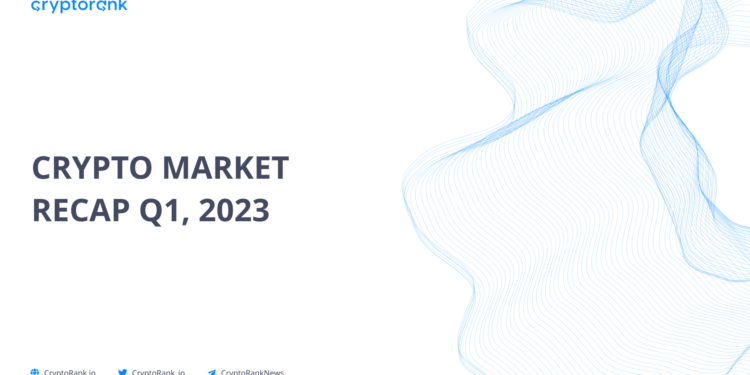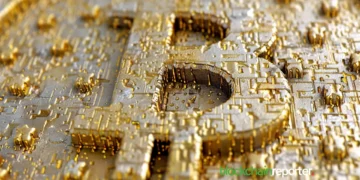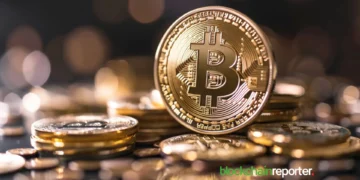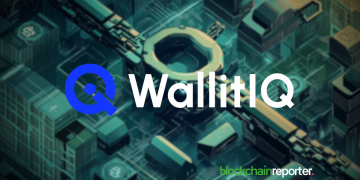What a way to kick off the new year! After a frustrating finish to the previous year, the year 2023 got off to an upbeat start, which was just like taking a deep, cleansing inhalation. The swift expansion of the market rapidly brought us to the levels that existed prior to the FTX crash, and the price of BTC is now very close to what it was in June of 2022. The difficult times of 2022 are now in the past, and the market is beginning to grow, unveiling massive airdrops, new projects, and token sales.
Funds are also now beginning to increase their investment activity in Web3, which is a positive sign. Despite this, Q1 2023 was successful, albeit with some difficulties. It is important to note that the majority of issues originated from TradFi rather than the cryptocurrency market itself. The financial crisis not only had a significant impact on the world’s financial system as a whole, but it also highlighted the benefits of Bitcoin. The current macroeconomic situation is rife with contradictions.
The global financial markets are grappling with inflation, which could result in a recession, and this poses a significant risk to all investment instruments, including cryptocurrencies. At the same time, the banking crisis threatens financial stability, and the solution may lie in printing more money. The Federal Reserve is facing a tough choice: either increase the interest rate to counter inflation or maintain it at around 6% to facilitate an expansion of the money supply. Given the current circumstances, it’s challenging to forecast how the crypto market will fare.
However, it’s evident that the issues plaguing the traditional financial system are propelling the adoption of cryptocurrencies and bolstering trust in Bitcoin. In this article, we’ll delve into the Crypto Market Recap Q1, 2023 by CryptoRank. We’ll examine the state of the crypto market, whether the bull market has already arrived or is yet to do so, the ongoing airdrop season, the recovery of DeFi, the rush towards Layer 2 solutions, the latest fundraising trends, and whether the NFT market has truly witnessed recent growth.
The Bull Market is on the Horizon
The early months of 2023 witnessed a turning point, as Bitcoin began to surge after a few weeks of subdued activity. Despite the negative occurrences, such as the Genesis controversy, January proved to be a highly prosperous month for Bitcoin and the wider cryptocurrency market. While February’s performance was average, the month of March ushered in new heights for the crypto space. In Q1, Bitcoin outperformed the other top-10 cryptocurrencies, but a few notable projects from the top 100 also showed significant gains.
One of these is Solana, which experienced a poor performance in Q3 due to its close ties with FTX but bounced back with a 109% increase in Q1. Another noteworthy project is Lido, which gained +134%, but we’ll discuss it later. Lastly, Aptos exhibited an exceptional growth of 230% in this quarter. CryptoRank’s Market Performance and Volatility Analytics highlight the top gainers in Q1. BTC’s performance during the weeks of banks collapsing was noteworthy as it proved to be the “Bitcoin moment”.

Moreover, BTC’s dominance reached a level not seen in almost a year. Although the moment had a profound impact on the traditional financial markets, it did not have a significant effect on the crypto space, despite USDC de-pegging from $1 and BUSD being banned by the government. Furthermore, despite some crucial legal cases against crypto firms and entities, the market remained robust. The list of gainers this quarter is varied and exhibits impressive numbers. Many projects gained substantial attention in the quarter, resulting in their price increases.
This was due to the market’s recovery and strong uptrends in specific ecosystems. The AI trend dominated the narrative, enabling several established crypto startups to boost their value. Consequently, any project that added “AI” to its name or features gained new funding or witnessed a price surge. DeFi was the best-performing category in Q1, particularly decentralized exchanges. Additionally, it’s worth noting that projects based on Layer 2 blockchains (Arbitrum and Optimism), including Camelot, Radiant Capital, Velodrome, and Gains Network, outperformed others.
The Airdrop Season has Finally Arrived
In February, the crypto community witnessed a significant event – a massive airdrop by Blur, one of the leading NFT marketplaces, worth around $300 million. The airdrop was aimed at engaging with the community and rewarding loyal NFT traders, and it turned out to be a profitable move for both Blur and its users. As a result, Blur became the largest NFT marketplace, surpassing OpenSea.
The platform’s loyal users not only received a substantial airdrop but also enjoyed numerous incentivizing activities to attract and retain new users in the preceding months. In terms of airdrops, March was even more remarkable. The middle of the month saw Arbitrum announcing its airdrop plan and the launch of its DAO. The massive Arbitrum airdrop grabbed a lot of attention, and for a good reason: it became the biggest airdrop ever. As a result, ARB quickly climbed into the top 50 and established a strong position in the chart.
The rise in airdrop activity is a significant catalyst for the crypto market, as it draws in new users and encourages existing ones to be more involved, leading to an increase in project fees. Blockchain infrastructure projects, which are the backbone of crypto, are particularly attractive to potential airdrop recipients. The pursuit of airdrops may serve as a signal for a market rebound prior to the start of a new bull run.
DeFi Experiences a Revival
As the market continues to grow, there has been a resurgence in DeFi. Although DeFi total value locked (TVL) is increasing at a slower pace compared to the market, this is mainly due to altcoins trailing behind Bitcoin in growth. Nevertheless, the emergence of new trends in DeFi indicates a promising recovery. Liquid staking is one of the latest trends in DeFi, which has become a crucial element in Proof-of-Stake networks and a significant source of income for validators and delegators.
With the upcoming Ethereum update, Shapella, allowing for staked ETH withdrawals, the popularity of liquid staking is only set to rise. Decentralized liquid staking providers have become increasingly popular among DeFi users due to the obvious benefit of receiving a derivative coin pegged to the amount of staked coins. The top performers in this space are Lido and Rocket Pool, which have shown outstanding performances in the first months of 2023.
Liquid staking protocols have surpassed lending and borrowing protocols in terms of combined TVL and are now the second largest after decentralized exchanges (DEXs). Currently, there are 78 protocols with a total TVL of over $16 billion, compared to DEXs’ 759 protocols and $19 billion TVL. When it comes to measuring the progress of DeFi’s revival, the total value locked has risen by almost 40% since the start of this year. While Ethereum maintains its dominant position among blockchains, there has been a considerable increase in TVL for Arbitrum, Solana, and Optimism during Q1 of 2023.
It is noteworthy that several protocols have seen a significant increase in TVL during Q1 2023, particularly those that have launched on new networks and garnered significant attention. Additionally, protocols operating on Layer 2, such as Camelot, Velodrome, and Gains Network, experienced a notable uptick in their total value locked. Among the top 15 protocols, Lightning Network stood out due to the growing adoption of Bitcoin as a payment method.
The first quarter of 2023 witnessed a rise of approximately 30% in DEX trading volume, after two consecutive quarters of decline. The DEX/CEX ratio also increased, reaching the level of November 2022. Currently, decentralized exchanges have strong positions in the market, allowing them to continue to grow. This growth can be attributed to factors such as low gas fees (although this is temporary) and the increasing awareness of Web3 users. The DEX/CEX ratio is still 4% below the all-time high of January 2022. However, with the increasing popularity of blockchain, this indicator may reach new all-time highs.
The Rush Towards Layer 2 Solutions
The Adoption of Layer 2 blockchains started in 2022 and is likely to continue in 2023. The rise began with Optimism, which grabbed the attention of the general public with its remarkable airdrop in 2022. Another optimistic rollup, Arbitrum, followed suit and introduced its incentivizing program, the Arbitrum Odyssey, which proved so popular that it even overloaded the network’s capabilities. The launch of these Layer 2 blockchains couldn’t have been better timed, with users enjoying all of Ethereum’s advantages but with greater speed, lower transaction costs, and increased capacity.
This year, the Layer 2 landscape witnessed a significant shift with the launch of an airdrop campaign by Arbitrum. During H2 2022, Arbitrum made rapid progress and many projects chose to launch on its network, including some of the biggest ones. Even without any clear airdrop plans, Arbitrum was already a popular choice among many users. The excitement generated by the Arbitrum airdrop provided an ideal opportunity for other projects to debut their mainnets and testnets.
Following the successful ARB airdrop, zkSync introduced the first zkEVM mainnet, the zkSync Era. This development garnered a great deal of interest and resulted in a surge in transaction volumes. Soon after, Polygon unveiled its much-anticipated zkEVM as a mainnet beta. Numerous other Layer 2 projects are now attracting attention not only from the crypto community but also from major venture capitalists.
Various companies have adopted Polygon’s expansion plan and built their own zero-knowledge technologies, including blockchains. ConsenSys, a leading cryptocurrency company, has recently released its public testnet for zkEVM called “Linea”. The launch of Coinbase’s L2 network, Base, is a reminder that we are still in the early stages of Layer 2 and there will be many more exciting rollouts to come.
Fundraising Sees Upward Trend
As the upward trend in the crypto market became more evident to investors, venture capitalists, and token sale launchpads moved quickly to capitalize on the opportunity. However, after the collapse of FTX, fundraising activities took a hit due to Alameda’s shutdown and lack of turnover money for further investments. Nonetheless, there has been a significant recovery in fundraising since January, with decent growth compared to December, and even better performance in March.
The trend has shifted towards infrastructure and service projects that have a tangible use case in the current market. The developments in public fundraising are particularly noteworthy. There was a notable improvement in token sale activity in February 2023, with an increasing number of successful launches. An upward trend has emerged, and in March, the monthly fundraising amount even surpassed that of May. Although IEOs like Binance Launchpad, Bitget, and Gate.io Startup offered the most profitable returns to investors, IDOs outnumbered IEOs.
AI projects were among the top performers in terms of current ROI for the top 10 projects. Space ID, in particular, exhibited impressive performance, showcasing Binance’s capabilities. Arbitrum emerged as the top blockchain for total funds raised through token sales in Q1 2023, primarily due to the success of several projects on Camelot. Nonetheless, BNB Chain and Ethereum surpassed Arbitrum in terms of the number of projects that conducted public sales during the quarter.
NFTs Facing Struggles Despite Increased Volume
Despite the growth of Bitcoin, altcoins, and DeFi, the NFT market has remained stagnant, except for an increase in trading volume. The majority of the increase in trading flow can be attributed to Blur’s airdrop, but the numbers are still quite impressive. Unfortunately, the substantial increase in price (presented in ETH) that many people anticipated would occur in response to the increased liquidity has not materialized.
As was just indicated, the overall market capitalization of NFTs only slightly reacted to the significant increase in trading volume. The NFT market was strongly pumped in 2021, and it continues to cool off, so it is not yet ready to continue its growth at this time. However, the adoption of NFTs goes hand in hand with the recovery of the market, but it is moving toward the use of NFTs by brands and organizations outside of the cryptocurrency industry.
The Bottom Line
Currently, the crypto market is experiencing one of its most favorable moments in a long while. The market’s impetus at the beginning of the year was seized, resulting in critical thresholds being crossed. Subsequent developments validated the market’s preparedness for expansion, with even Bitcoin responding to negative news with a small and brief dip. Naturally, the volume is still somewhat modest, and the low volatility requires consideration, but the contrast with late 2022 is unmistakable; the markets are awakening.
The market has, in a sense, propelled itself forward through a series of events sparked by optimistic expectations. The airdrop by Blur served as a catalyst for other projects (such as Arbitrum) and drop hunters, leading to heightened activity and prices. This, in turn, reignited fundraising efforts, both in terms of private investment and the number of successful public sales and their returns. Moreover, a conflicting macroeconomic landscape created a favorable moment for crypto, making this one of the most noteworthy periods in the history of cryptocurrencies.
The next Bitcoin halving is just a year away, yet challenges persist. It is crucial to monitor the global macroeconomic outlook more than ever. Crypto is becoming increasingly vital to the global economy, with more entities opting to engage with it, despite potential government opposition. Financial market disruptions could also impact the crypto market, particularly affecting the valuations of crypto startups as one of the riskiest investment types. Nonetheless, during such times, cryptocurrencies may demonstrate their resilience, solidifying their position within the global payment system.























